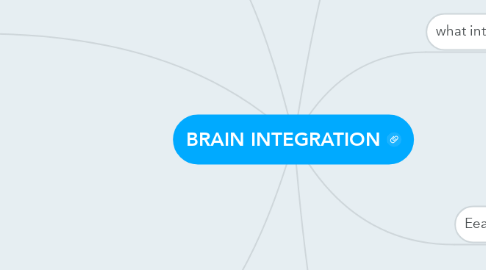
1. def.
1.1. linking different elements together to make a well-functioning whole.
1.2. Integration takes the distinct parts of your brain and helps them work together as a whole.
1.3. It’s similar to what happens in the body, which has different organs to perform different jobs: the lungs breathe air, the heart pumps blood, the stomach digests food. For the body to be healthy, these organs all need to be integrated.
2. what integration does:
2.1. it coordinates and balances the separate regions of the brain that it links together.
3. dis-integration.
3.1. overwhelmed by their emotions,
3.2. , confused
3.3. chaotic.
3.4. They can’t respond calmly and capably to the situation at hand.
3.5. Tantrums, meltdowns, aggression,
4. What molds our brain?
4.1. brain structure
4.1.1. hundred billion neurons
4.1.2. ten thousand connections bet. neurons
4.2. experiences
4.2.1. change the physical structure of the brain.
4.2.2. make
4.2.2.1. brain cells active, or fire.
4.2.3. build
4.2.3.1. new connections
4.2.4. called
4.2.4.1. “rewiring”
4.2.4.1.1. create and reinforce the integrative fibers
4.2.4.1.2. work together even harmoniously.
4.2.5. create and reinforce the integrative fibers
4.3. the nature of our mental activity,
4.3.1. determines by
4.3.1.1. activation of particular circuits in the brain
4.4. EX
4.4.1. Shy children
4.4.1.1. parents behavior
4.4.1.1.1. supportive explorations
4.4.1.1.2. lead to loss shyness.
4.4.1.2. parents behavior
4.4.1.2.1. excessively protected
4.4.1.2.2. maintain shyness.
4.5. parents shape child’s brain by experiences
5. what to do
5.1. help brain become more integrated
5.2. to use mental resources to full capacity.
6. Eea Woo woo
6.1. child
6.1.1. scary and traumatic emotions
6.1.2. in his right brain
6.2. mother
6.2.1. factual details and logic
6.2.2. from left brain
6.3. if not
6.3.1. fears unresolved.
6.3.2. might developed a phobia
7. facts
7.1. lack of integration in children
7.1.1. no time to develop.
7.1.2. fully developed at mid-twenties.
7.2. influence by
7.2.1. offering opportunities to exercise
7.2.2. present with children .
7.2.2.1. so better integrated

